Daryl Hostrawser: Canadian Champion Plower
After waiting and practising for two long Covid years, it’s time to head to Ireland to compete in the World Ploughing Championship.
When I visited Daryl Hostrawser in East Garafraxa back in 2019, there were no salt and pepper shakers on the kitchen table of the modest, brick bungalow he calls home. No sugar bowl. No bottles of clotted sauce.
What was on the table was the substantial trophy awarded annually by the Canadian Plowing Organization to the national plowing champion in the reversible class.
The trophy’s boxy wooden base was garnished with rectangular name plates honouring past winners, many names repeating: Bert Beyens, Brian Fried, Robert Campsall. Atop the base was what appeared to be a large abstract butterfly, fashioned in gleaming chrome. Few would see the “butterfly” for what it actually is: the palm-sized representations of the upper and lower moldboards of a farmer’s reversible, or rollover, plow.
Daryl, who was 63 at the time, sat back in his chair, rubbed a large, well-worn hand across his grey-bearded chin and admitted his name was not on the trophy. Yet. Oh, he won the 2019 national championship in his class, after many years of trying, but he just hadn’t gotten around to finding someone who could match the etched typeface needed to add his own nameplate to the ranks of the others.
More than two years later, in the spring of 2022, Daryl, his name only recently etched onto a plate on the trophy, sat patiently at that same table, waiting. Waiting for worldwide Covid-19 restrictions to cease. Waiting for the World Ploughing Championship, scheduled for late September in Ireland, to be confirmed. Waiting for his chance to become world champion.
Daryl remains national champion because, until this spring, all domestic plowing competitions were cancelled due to the pandemic. Although Daryl did not compete at the recent 2022 national championships in Manitoba, he will represent Canada at the 2022 Worlds. The newly crowned 2022 Canadian champion will represent this country at the 2023 Worlds.
Daryl comes from a long line – a long and perfectly straight furrow – of competitive plowers. His grandfather George won trophies from the Etobicoke Agricultural Society as early as 1904, and in 1953, his Uncle George was a judge and coached the Canadian team at the first World Ploughing Championship in Coburg. His father, Bill, was Ontario champion in 1962 and competed for Canada at the Worlds in 1964.
And in 2016, Daryl’s brother Bill was reserve champion (runner-up) in the antique tractor class at Ontario’s International Plowing Match. Daryl has been provincial champion eight times in two classes, conventional and reversible, and reserve champion in national competition three times. He went on to the Worlds as a competitor in 1988, 1991 and 2002, and many more times as a coach.
But he isn’t resting on his laurels. Retired from dairy farming, Daryl still plows about 30 to 40 acres of his 200-acre East Garafraxa farm, producing about a thousand bales of hay for the dairy industry. More often – quite often, actually – he is elsewhere on his land. Practising.
He can be seen twisted in the seat of his 1991 Ford PowerStar 7740 SL tractor, diligently looking back over a 1986 Kverneland two-furrow rollover plow, monitoring that the furrows it leaves are perfectly straight, of uniform depth and at an angle of precisely 135 degrees.
The aim in plowing is efficiency and soil conservation; to cut, lift and rotate turf, skimming the roots off grass and weeds so they can’t regrow, and placing earth at exactly the right angle so that wind crossing the fields deposits precious soil back into the furrow, instead of blowing it away to some unproductive yonder.
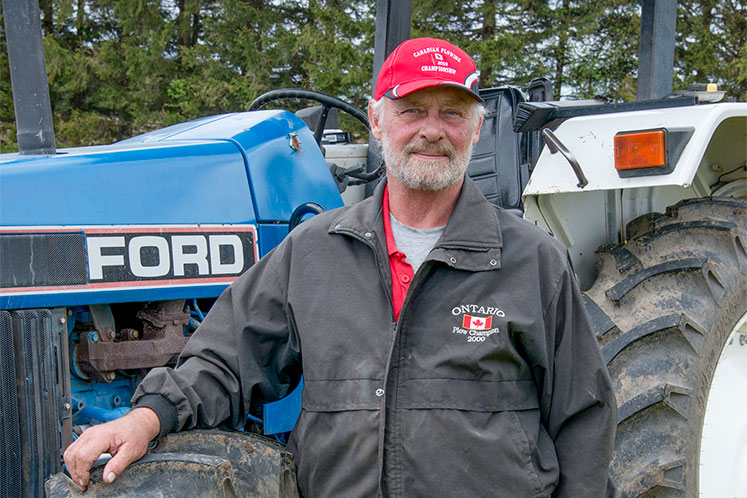
“If somebody goes out and rips up a big mess, he’s got to go over it two or three times more than I would to level it,” says Daryl. Photo by Pete Paterson.
Uniform depth. Perfectly straight. Angled just so. “It’s dirt, who cares?” you may wonder. “I care,” Daryl said quietly, and he doesn’t have to swear on a stack of seed catalogues to convince me. His feelings are evident in the cellphone photo gallery he proudly shows, unbidden – shot after shot of furrowed field after furrowed field, symmetrical lines of earth he has plowed across the country and around the world.
As we enter his driveshed, his pride is also evident in the smile of satisfaction that blossoms as he stands back and admires his tractor and plow. Well-used, dirty and esoteric though the equipment is, you can still see brutally efficient agricultural art: a motorized, mud-caked sculpture by the likes of Alexander Calder.
The plow rig is a tangle of thick metal frames, painted orange, red and green. Mounted on little rubber wheels, these frames are decorated with four vicious-looking, platter-sized coulters – metal discs that cut the soil and can cut you when they are competition sharp. Gleaming prongs, called shears, tip four large, inch-thick, black plastic slabs. These are the all-important moldboards that angle the soil out and to the side.
All this colourful complexity is mirrored, above and below, on the rollover plow Daryl uses. When the tractor turns around at the end of a furrow, hydraulics cause the whole plow assembly to rise and roll over, so the moldboards always plow the furrow slices up and out in the same direction.
The bits and bolts that lie strewn on the swept concrete floor are the detritus of Daryl’s continuing modifications to the mountings of those moldboards – and to depth-wheel assemblies. Fine-tuning in search of perfection.
The tractor is bright blue and white, its smallish seat “comfortable enough.” It has a big blue canopy, cheese-grater gas, brake and clutch pedals, and a steering wheel the size many of us remember on our grandparents’ cars. The tractor seems to be all engine – and that engine is immaculate.
The tractor has tiny front wheels and, on massive white hubs, rear wheels as high as a person’s chin – if the person doesn’t mind a dirty chin. In the cab, a handful of stubby gear levers that work 12 forward gears (two-thirds of them “low”) are topped with knobs like snooker balls. A thousand pounds of glossy black weight plates are stacked at the tractor’s nose for traction, and a snake’s nest of black hydraulic lines thrash from the tractor’s rear. All this to cut shallow lines in the earth. Precisely. Competitively.
How did a workaday rural chore such as plowing become a competitive event? Showing off. Being demonstrably better than the plower on the farm next door, better than all the plowers on the farms in the vicinity.
“People normally plow the length of a field,” Daryl explained. “There are fewer turns, fewer rounds. It’s just easier. Back in the day, a good plower would plow perpendicular to the road so people going down the road could see what a good job he did. He was showing off. The ones that weren’t so good would plow parallel to the road. Nowadays they don’t plow – or don’t care. I care. If I drive past a plowed field, I look.” Farmers looking – farmers caring – led to farmers competing.
These days, however, farmers plow much less frequently, if at all. “For the cropping people, it takes too long,” said Daryl. “There’s a lot of no-till or minimum-tillage now. They take off a crop and use a seed drill designed to just penetrate the soil, as is. It’s common. Maybe every three or four years they’ll plow, if hard soil dictates. You have to be so efficient nowadays to make money growing crops.”
Daryl then changed the subject with a smile of anticipation. “Nobody gets any money. Zero,” he said, for winning the Golden Plough or the Golden Furrow Challenge Trophy, the awards for conventional and reversible classes respectively, at world competitions.
The 67th Annual World Ploughing Contest was to have taken place in 2020 outside St. Petersburg, Russia. The event rotates around the globe and was last hosted by Canada in Olds, Alberta, in 2013. National champion plowers, most of them male, from 37 countries were expected to compete in three classes: conventional, reversible and juniors.
Daryl was one of those expected to compete. But no one expected Covid-19, which led to a two-year postponement of the international competition. Then came this year’s Russian invasion of Ukraine – and, in response, the relocation of the match to County Laois (pronounced Leesh), Ireland.
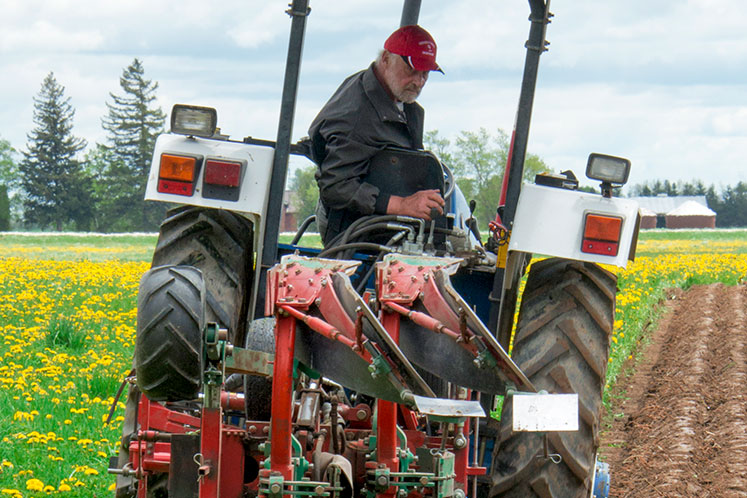
Daryl Hostrawser spends 20 hours a week perfecting his plowing technique on his farm in East Garafraxa. Photo by Pete Paterson.
Daryl has been a patient plower. And a thoughtful one. “The Worlds have been off and on, back and forth, but I’d rather stay home and be safe than go and get somebody sick, or get sick myself,” he said. “If the match doesn’t go ahead this year, I’ll be out of luck.” He’ll be superseded at the 2023 Worlds by the newly crowned 2022 Canadian champion.
For Daryl, the Worlds are a “big deal,” not least because of the cost. He estimates his out-of-pocket expense for sending his tractor and plow to Ireland will be between $10,000 and $15,000.
But the world competition will be the culmination of a three-year cycle of success. He won the Ontario reversible championship in 2018, which qualified him to compete at the national championships in 2019. His win there, in Sunderland, Ontario, qualified him to represent Canada at the Worlds in 2020, a competition delayed until this year.
Daryl’s best finish in world competition, his proudest moment overlooking a plow, came in Amana, Iowa, in 1988, when he placed seventh in the conventional class.
Looking ahead to this year’s international competition, he’s excited, but realistic. Canadian weather doesn’t allow enough seat time, even considering Daryl’s average 20 hours’ practice a week, in season. “I still have farming to do. There are people over there (in Europe) who take it more seriously than I do,” he said, straining credulity.
“Over in Europe,” he added, “it’s totally competitive. Not everywhere is under four feet of snow. There is a competition somewhere nearly every weekend. Put the tractor on a trailer and go 40 or 50 kilometres. They have their plow in the ground more. They’ll work on their plows, trying something a little different, and have more chances to see what works and what doesn’t. For a Canadian to win it all? Nearly impossible.”
Nonetheless, he hoped to travel to Ireland for love of the competition and in hopes of a top-10 placing. And for the camaraderie, the friendships made with international plowing peers over decades.
“World plowing is done to promote good soil tillage and conservation, and to highlight co-operation between nations around the world,” said Daryl. “Doing a good job is efficient. If somebody goes out and rips up a big mess, he’s got to go over it two or three times more than I would to level it, or bring in seed drills.” Don’t try this at home, evidently.
But go and watch someone else do it? Audiences at domestic plowing events are small. In Europe, a plower working a precisely defined competition area called a “land,” might be watched by a roped-off, appreciative crowd standing five deep. When not on his plow, Daryl has been one of those spectators.
The secret of a great plower is “attention to detail,” said Daryl. “You want to know what the plow is going to do before you put it in the ground. Depth. Straightness. Uniformity. Finish (ends of rows) perfect to within a half-inch. Getting off and measuring. Making minute adjustments. The more you know, the more you see.”
Those really seeing are the judges, who assign scores, and stewards, who examine equipment and enforce rules (no outside assistance, no cellphones, no touching plowed earth with hand, foot or stake). Competitors in the reversible class have three hours to plow an irregular 16- by 24- by 100-metre land.
As spring turns to summer and a crop sprouts from Daryl’s exemplary East Garafraxa furrows, he is pleased, prepared – and in pain. He’s in urgent need of hip surgery, but the Worlds will take precedence. “I’m going,” he said with quiet determination.
“I’m at the end of my plowing career,” he added. “I’ve accomplished everything I wanted to. I don’t have trouble sitting on a tractor. It’s just that I don’t seem to move too well walking away from it.”
Regardless of how he fares in this fall’s World Ploughing Contest, Daryl Hostrawser is, to use the well-worn dad joke just this once, a man outstanding in his field. And that field will be, as it always is, an earthen work of art.
Related Stories
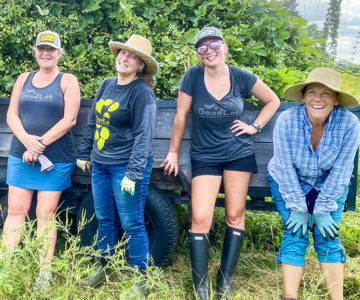
Seize the Local Moment
Jun 24, 2022 | | FarmingWe’re lucky to live in a farm region that cares so much about food and that is embracing new opportunities in food education and ecoliteracy.
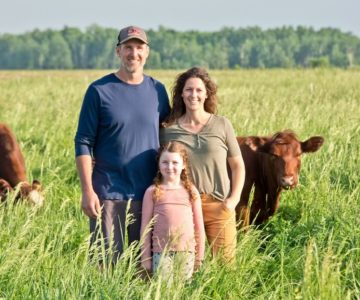
Regenerative Agriculture Puts the Soil First
Jun 22, 2021 | | FarmingHow cover crops, crop rotation and using livestock to fertilize fields puts local farmers on the front lines in reducing climate change.
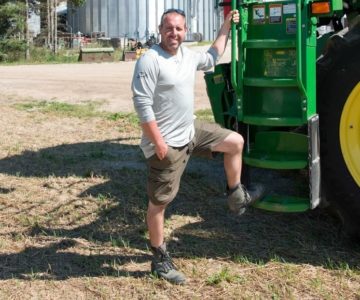
Meet the Farmers
Sep 24, 2021 | | FarmingBert Tupling, Mike Swidersky and Darryl Burnett criss-cross Dufferin County tending to wheat, barley, corn, potatoes, cattle, sheep and more.

Farmers at the Table
Sep 24, 2021 | | FarmingThree Dufferin farmers sit down talk about what it means to be a modern farmer, the challenges they face and what they wish we knew about them.
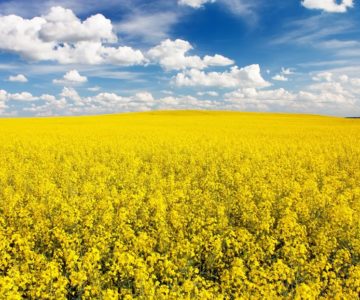
An Exurbanite’s Guide to Field Crops
Sep 24, 2021 | | FarmingA drive-by primer on what’s growing in Headwaters.
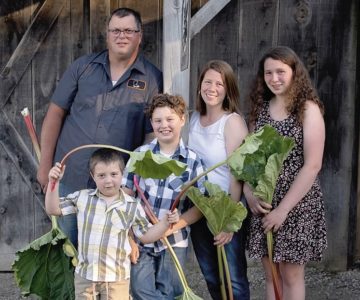
Work in Progress
Jun 22, 2021 | | FarmingAs farmer Jeannette French notes, farming in Headwaters may always be a work in progress, but this community provides the motivation it takes to forge ahead.










